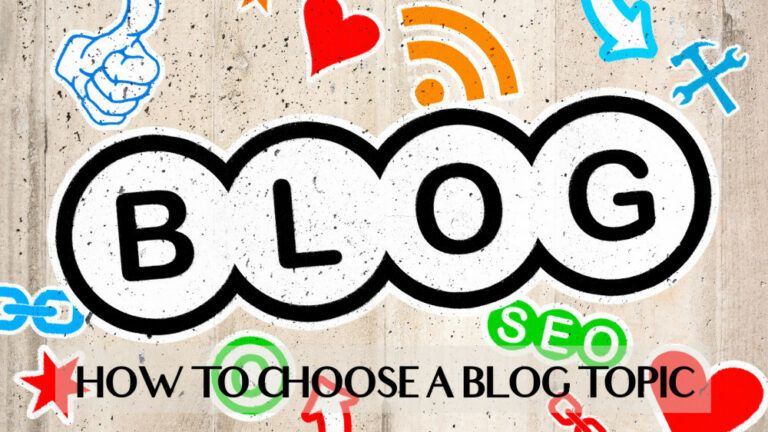How To Start A Sports Blog And Turn Passion Into Profit
Starting a sports blog is a thrilling way to turn your passion for sports into a profitable venture. If you’ve always had a keen eye for analysis or a love for sharing game-day excitement, this is your opportunity to connect with like-minded fans.
In this guide, we'll walk you through how to start a sports blog, covering essential steps, tips, and strategies to help you turn your passion into a successful business.
What Is A Sports Blog?
A sports blog is an online platform where enthusiasts, journalists, or professionals write and share content related to the world of sports.
These blogs cover various topics, including in-depth analysis of games, player performances, and team strategies. They also provide updates on news and events, such as transfers, injuries, and competition outcomes.
Many sports blogs focus on specific sports like football, basketball, or cricket, catering to fans who want the latest insights and discussions.
In addition to traditional game coverage, sports blogs often feature expert opinions, match previews, and post-game reviews. They may also cover training tips, fitness advice, and sports-related lifestyle topics.
Many sports blogs aim to build a community of fans by encouraging interaction through comments and social media shares.
Some sports blogs generate income through advertising, affiliate marketing, and sponsored content, making them a lucrative platform for casual writers and serious sports professionals.
Steps To Start A Sports Blog
Starting a sports blog combines your passion with a path to profit. These are the crucial steps for launching and expanding your business, from choosing a specialty to marketing your content.
1. Define Your Niche
Selecting a topic that satisfies a market need and represents your enthusiasm is the first step in launching a sports blog.
The sports world is vast, from individual games like soccer or basketball to specialized topics like fantasy sports or athlete training routines. Begin by listing your interests and assessing what you can write about consistently.
Keyword research tools such as Ubersuggest or Google Trends can be used to investigate competition and demand. It's also a good idea to scope out existing blogs to find what’s working and where there's room for innovation.
Narrowing your niche—for example, focusing on a specific league or team—can make your content stand out and attract a loyal audience.
Key Points
- Choose a sport or topic you’re passionate about.
- Use tools like Google Trends to assess popularity.
- Study your competition to find content gaps.
2. Research Your Target Audience
You need to know who your readers are to provide content that appeals to them. Start by identifying their age group, interests, and pain points.
Are they casual fans, hardcore analysts, or fantasy sports enthusiasts? Use tools like Reddit, Twitter, or sports forums to observe discussions and gather insights.
Develop audience personas—detailed descriptions of your ideal readers, including demographics, goals, and challenges.
For example, a 30-year-old fantasy football enthusiast may seek draft advice and player stats. By getting to know them, you may adjust your writing style, content topics, and promotion tactics to your audience's tastes. The better you understand your readers, the more engaging and relevant your blog will be.
Key Points
- Identify who your readers are and what they care about.
- Use social platforms to gather audience insights.
- Build reader personas to guide content creation.
3. Choose A Blogging Platform
For long-term success, choosing the appropriate blogging platform is essential. WordPress.org is highly recommended because of its flexibility, plugin support, and strong SEO capabilities.
If you prefer ease of use and don’t mind limited control, consider Wix or Squarespace. Start by buying a domain name that’s short, relevant, and easy to remember.
Purchase a hosting plan from companies such as SiteGround or Bluehost. Then install WordPress and pick a theme suitable for a sports blog—look for clean layouts, mobile responsiveness, and customization options.
Add essential plugins like Yoast for SEO, WPForms for contact forms, and Jetpack for analytics and security. A reliable platform sets the foundation for your blog's growth and monetization.
Key Points
- WordPress.org is best for customization and monetization.
- Buy a domain name and reliable hosting.
- Use essential plugins for SEO and analytics.
4. Design Your Sports Blog
An attractive and user-friendly design keeps visitors engaged and encourages them to return. Start with a homepage that features the latest posts, highlights, and trending news.
Organize content using a clear menu with categories like News, Analysis, Reviews, and Interviews. Use a customizable WordPress theme such as Astra or GeneratePress and enhance it with a page builder like Elementor.
Make sure your design is mobile-responsive and loads quickly—use tools like GTmetrix or Google PageSpeed Insights to optimize speed.
Add a sidebar with widgets for social media feeds, popular posts, and newsletter sign-ups. A visually appealing blog boosts user experience and increases time spent on your site, positively impacting SEO.
Key Points
- Keep the layout clean, organized, and mobile-friendly.
- Feature the latest and popular posts on the homepage.
- Use speed optimization tools for faster load times.
5. Plan Your Content Strategy
Creating a consistent and purposeful content strategy is essential for attracting and retaining readers. Identify your core content types, including match previews, game recaps, player interviews, opinion pieces, and historical insights.
Start with one or two posts a week, depending on how often you can publish fresh content without sacrificing quality. Build an editorial calendar using tools like Trello or Google Sheets to plan content for a month.
Mix evergreen content (e.g., training tips or game rules) with timely topics (e.g., game reviews or transfer news). Always keep your target audience in mind and consider seasonal trends, major tournaments, and fan interests. A solid plan will guide your content creation and prevent burnout.
Key Points
- Identify core topics like recaps, opinions, and interviews.
- Mix evergreen and trending content.
- Use an editorial calendar for consistency.
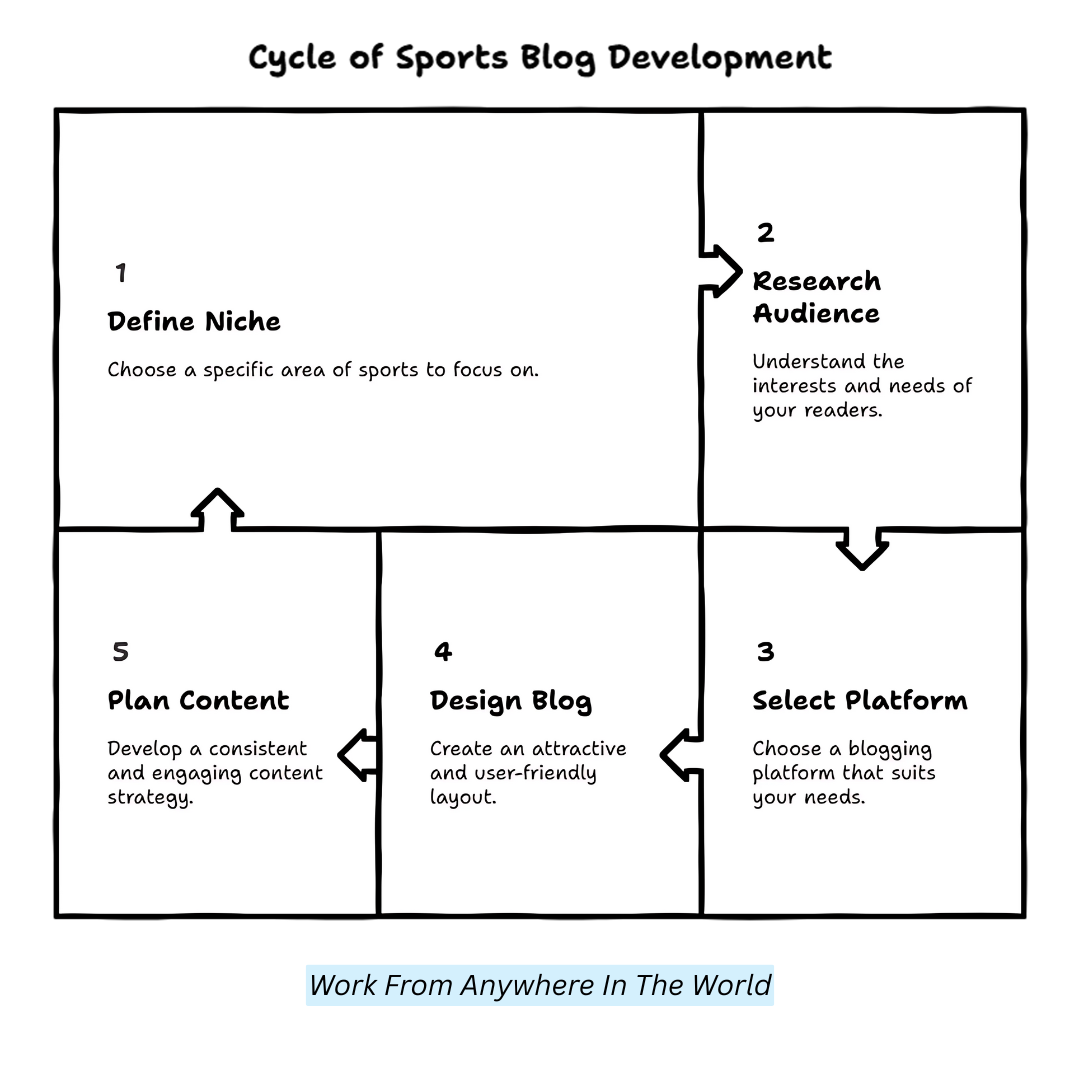
6. Create High-Quality Content
Your content is the core of your blog—make it count. Start with thorough research to ensure accuracy and depth. Use a conversational tone to make your writing approachable, but back up your claims with reliable data and statistics.
Incorporate engaging elements like images, highlight reels, infographics, and quotes from athletes or experts. Write compelling headlines to draw readers in, and structure posts with subheadings, bullet points, and short paragraphs for easy reading.
Use tools like Grammarly for proofreading and Yoast SEO to optimize your posts. Aim for 1,200 to 2,500 words per post, depending on the topic. Quality content builds trust, encourages sharing, and boosts your search engine ranking.
Key Points
- Write in a conversational, data-backed style.
- Add media like images and infographics.
- Optimize posts for SEO and readability.
7. Promote Your Blog
Promotion is vital for attracting readers beyond your immediate circle. Begin by tailoring captions and hashtags for each audience by sharing your posts across all major social media platforms—X (Twitter), Facebook, Instagram, and TikTok.
To share your content and take part in debates, join sports groups on Facebook Groups, Reddit, and Discord. Speak with other blogs about backlink exchanges and guest posting opportunities. Set up an email newsletter with tools like Mailchimp to keep your audience updated.
Use SEO techniques—target long-tail keywords, write meta descriptions, and build internal and external links. Don’t overlook paid ads or collaborations with influencers for additional exposure. Effective promotion amplifies your reach and accelerates growth.
Key Points
- Share content across major social platforms.
- Join sports forums and communities.
- Use SEO and email marketing to build traffic.
8. Build A Community
Fostering a community turns one-time visitors into loyal readers. Start by encouraging comments on your posts and take time to respond thoughtfully.
Use interactive content like polls, quizzes, and live chats to engage your audience. Create exclusive spaces such as a Facebook Group or Discord server where readers can interact, share opinions, and suggest topics. Consider featuring reader comments or guest posts to build inclusion.
Ask for input regularly to find out what your audience wants more (or less) of. Participation in the community increases recurring business and shares by fostering loyalty and trust. A strong community supports your blog and helps it grow organically through word of mouth.
Key Points
- Enable comments and respond regularly.
- Host interactive events like polls or live chats.
- Create exclusive groups to deepen engagement.
9. Monetize Your Blog
You can start monetizing your blog once you have consistent traffic and a loyal audience. Start with affiliate marketing—join programs like Amazon Associates, Fanatics, or sports ticket platforms, and promote relevant products using special links.
Add Google AdSense or Mediavine ads for passive income through impressions and clicks. Request product reviews or sponsored material from brands.
Launch a merchandise line using services like Printful or Teespring. Offer premium content, memberships, or fantasy sports strategies behind a paywall.
Additionally, you can produce and market digital goods like e-books and online courses. Reinvest profits to expand your blog further and diversify your sources of revenue for long-term viability.
Key Points
- Use affiliate links, ads, and sponsored posts.
- Sell merchandise or premium content.
- Create digital products like courses or eBooks.
10. Analyze And Improve
Regular analysis helps you understand what’s working and where you can improve. Track page visits, bounce rate, and traffic sources using Google Analytics.
Tracking keyword ranks and identifying technical problems are made easier with Google Search Console. Tools like Hotjar allow you to see how visitors interact with your blog through heatmaps and recordings.
Review top-performing content monthly and recognize patterns—what formats, topics, or titles generate the most engagement?
Make use of these tips to improve your SEO and content strategy. Experiment with new formats like videos or podcasts and test different promotion strategies.
In the fast-paced world of sports blogging, being current and competitive requires constant growth.
Key Points
- Use Google Analytics and Search Console.
- Study heatmaps and user interaction tools.
- Optimize based on performance data.
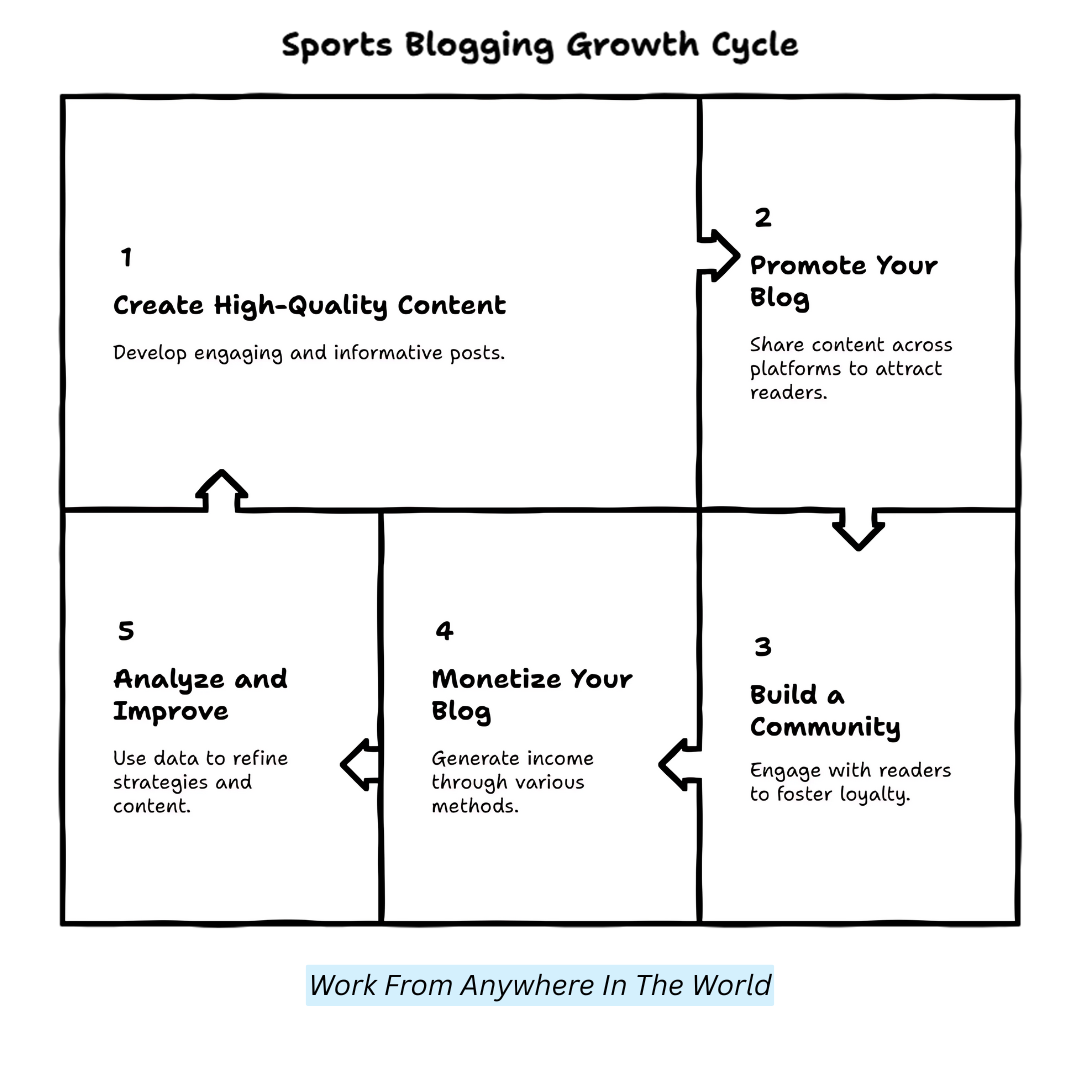
Profitable Sports Niche Ideas For Blog Writing
Here are 10 profitable sports niches that are especially well-suited for blogging, focused on written content, SEO potential, and monetization through affiliate links, ads, digital products, or services:
1. Fantasy Sports Tips & Analysis
A blog focused on fantasy football, baseball, or basketball can attract thousands of readers seeking weekly picks and strategies. Write stat-driven posts with a confident, analytical tone.
Topics like “Top Fantasy Football Sleepers for Week 8” work great for SEO. Monetize via affiliate links (e.g., FanDuel), Google AdSense, or premium memberships.
Estimated monthly income: $500–$5,000, depending on traffic. Use charts, player rankings, and predictions to engage seasoned players and beginners alike.
2. Sports Gear Buying Guides
Product-based blogs that compare and review sports equipment (e.g., cleats, bats, watches) are evergreen. Write with a neutral, informative tone, including comparison tables, pros/cons, and affiliate links.
Blog ideas: “Best Soccer Cleats for Wide Feet,” “Top 5 Budget Baseball Gloves for 2025.” Depending on traffic and buyer intent, Amazon Affiliate earnings can reach $300–$3,000 monthly.
To rank highly on search engines and turn readers into customers, give long-form content and SEO optimization top priority.
Wealthy Affiliate – Mini Review (2025)
If you’ve ever thought about turning your blog, passion, or niche into an online business,
Wealthy Affiliate (WA) is one of the most beginner-friendly platforms I’ve used.
It combines step-by-step training, website hosting, SEO research tools,
and an active community all in one place.
What I like most: you can start free (no credit card needed),
explore lessons, test the tools, and connect with other entrepreneurs
before upgrading. WA isn’t a “get rich quick” scheme — it’s a platform where success comes
from consistent effort and applying what you learn.
3. Sports Nutrition For Athletes
Blogging about meal plans, hydration strategies, and supplement reviews for athletes can attract fitness-minded readers. Write in a friendly, science-informed tone with clear sections, infographics, and recipes.
Topics like “Meal Plan for Teenage Basketball Players” or “Best Supplements for Marathon Runners” are highly searchable.
Monetize through affiliate links (protein brands, meal kits), digital cookbooks, and AdSense. Monthly income potential ranges from $500 to $4,000. Include macro breakdowns, expert quotes, and downloadable meal guides.
4. Youth Sports Coaching Tips
A blog targeting parents and amateur coaches with practical drills, game strategies, and motivation tips has strong potential. Use an encouraging and instructional tone.
Topics: “10 Easy Soccer Drills for Kids Under 10” or “Baseball Batting Tips for Beginners.” Offer printables, video demos, and PDF coaching guides for $5–$20.
Monetize through digital product sales and affiliate links to gear. Earnings can reach $500–$3,000/month. Consistency and easy-to-follow formats will keep parents returning for help.
5. Sports Injury Prevention & Rehab
Athletes and coaches search for trusted recovery advice. Create blog posts on injuries, stretches, and rehab routines. Use a professional, medically informed tone.
Topics like “How to Prevent Tennis Elbow” or “Post-Workout Stretches for Runners” rank well. Monetize through affiliate links (foam rollers, braces), eBooks, or digital injury guides.
Potential earnings: $500–$3,500/month. Back content with research, diagrams, and step-by-step recovery routines. Add expert interviews or PT quotes to enhance credibility.
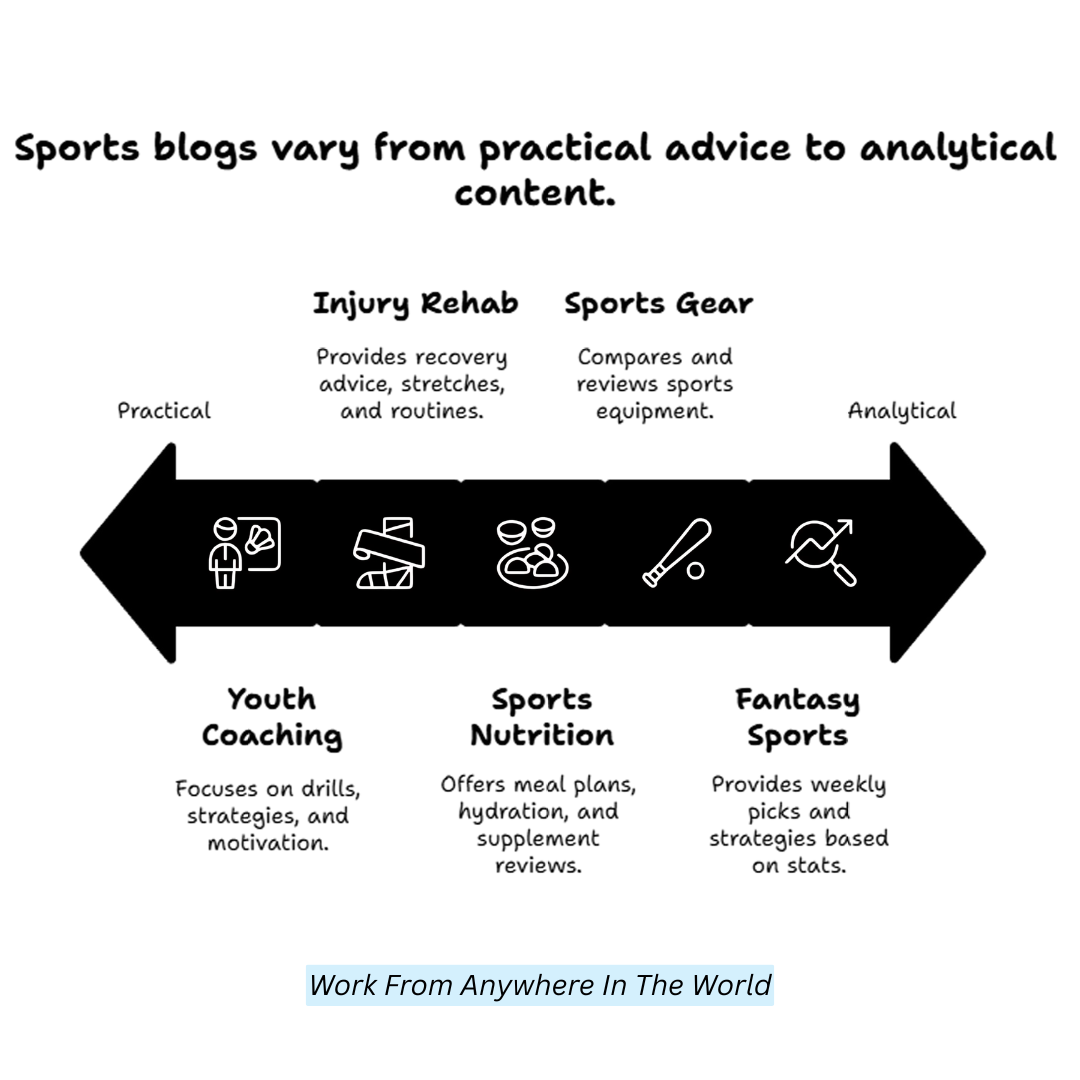
6. Running For Beginners
Running blogs are widely popular among fitness beginners. Use a motivating and supportive tone to guide them through gear, training plans, and recovery.
Blog examples: “5K Training Plan for First-Time Runners” or “Best Running Shoes for Flat Feet.” Monetize via shoe and app affiliate links, eBooks, and display ads.
Monthly earning potential: $500–$4,000. Structure posts with subheadings and simple language. Offer PDF training plans and beginner challenges to increase engagement and email signups.
7. Sports History & Player Biographies
For sports fans who love storytelling, this niche allows deep dives into iconic athletes, games, and teams. Use a narrative, journalistic tone with vivid descriptions and archival images.
Topics: “The Rise of Kobe Bryant” or “Top 10 Greatest Moments in World Cup History.” Monetize with display ads, book affiliate links, and merch.
Earnings can reach $300–$2,000/month. Strong storytelling, consistent publishing, and emotional hooks can help attract and retain loyal readers.
8. Outdoor Adventure & Endurance Sports
Cover sports like triathlons, trail running, or mountain biking through detailed guides, training tips, and gear reviews. Write in an energetic, adventurous tone.
Blog topics: “Best Hiking Trails in Colorado for Runners” or “What to Pack for Your First Triathlon.” Affiliate earnings from gear and apparel can total $500–$4,000/month.
Include images, trail maps, and personal stories to connect with readers. Focus on helpful, actionable content with a touch of inspiration.
9. College Sports Blog (Team or Conference-Based)
Niche down to one NCAA team or conference and cover games, recruiting, and stats. Write in a fan-focused, informative tone.
Topics: “Big Ten Week 6 Recap & Predictions,” “Top Recruits for Alabama Football 2025.” Monetize via display ads, team merch, or Patreon.
Monthly potential: $300–$3,000. Stay consistent and timely. Use recaps, rankings, and interviews to grow a loyal following and improve search visibility during peak sports seasons.
10. Home Sports Practice Setups
Teach readers how to build practice spaces at home—ideal for parents or athletes. Blog about backyard batting cages, indoor basketball hoops, or golf nets. Use a practical, DIY tone.
Topics: “Best Indoor Basketball Hoops for Apartments” or “How to Build a Backyard Pitching Mound.” Monetize with affiliate links to tools and gear, plus downloadable setup guides.
Potential income: $500–$3,500/month. Include photos, tutorials, and step-by-step instructions for high-value, evergreen content.
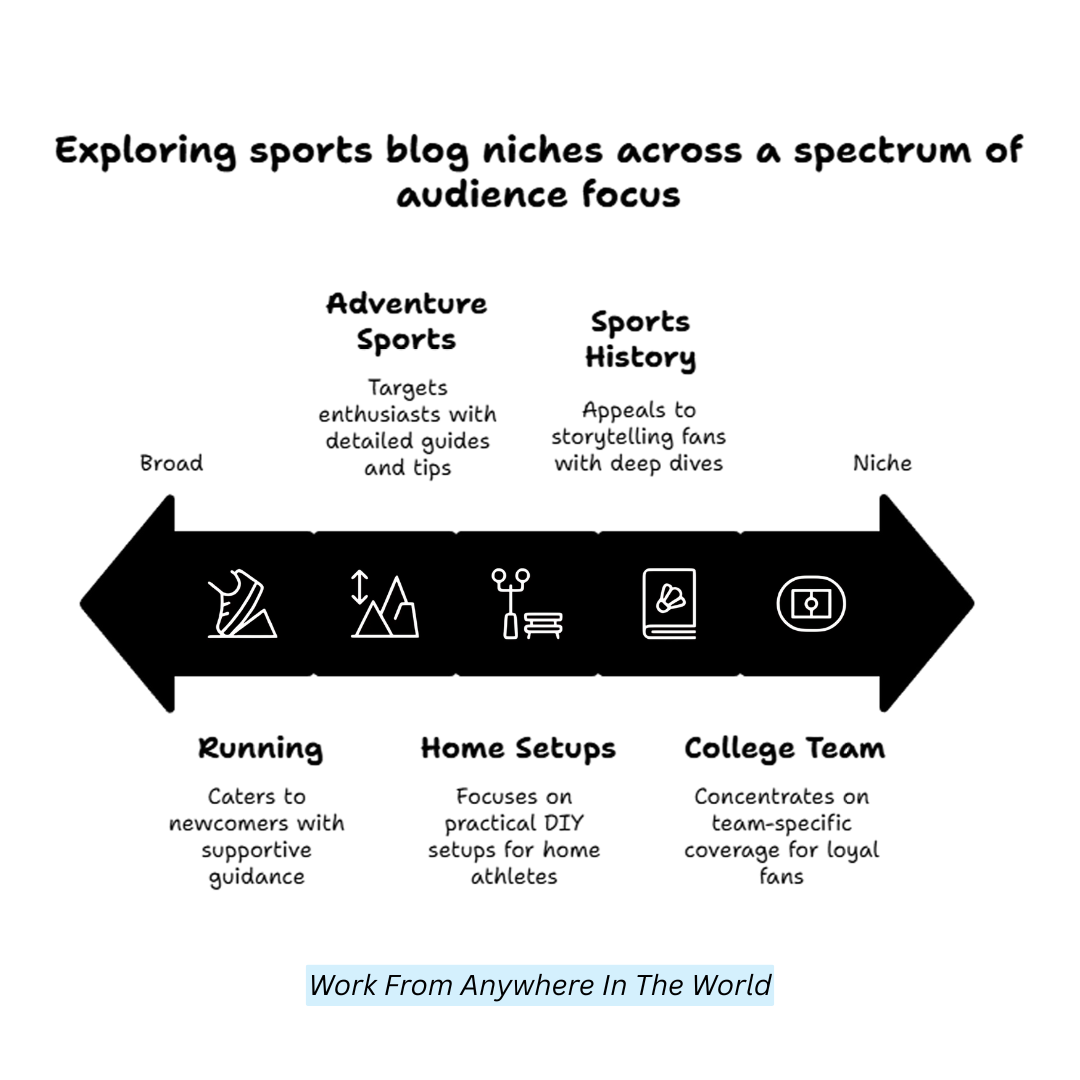
Conclusion
In conclusion, starting a sports blog is not just about sharing your passion; it’s about building a community and creating valuable content that resonates with your audience.
You can turn your sports blog into a profitable venture by following the right strategies, staying consistent, and focusing on monetization. Now that you know how to start a sports blog, it's time to leap and turn your love for sports into a thriving business!
I trust you enjoyed this article on How To Start A Sports Blog And Turn Passion Into Profit. Please stay tuned for more insightful blogs on affiliate marketing, online business, and working from anywhere in the world.
Take care!
— JeannetteZ
💬 Your Opinion Is Important To Me
Do you have thoughts, ideas, or questions? I’d love to hear from you. Please leave your comments below or email me directly at Jeannette@WorkFromAnywhereInTheWorld.com.
📚 More Work From Anywhere Reads
🚀 Ready to Build a Business You Can Run from Home
Or from Anywhere in the World?
Imagine creating income on your terms — from home, a cozy café, or wherever life takes you.
With the right tools, training, and community support, it’s entirely possible.
Start your own online business for free — no credit card needed.
Disclosure
This post may contain affiliate links. As an Amazon Associate and participant in other affiliate programs, I earn from qualifying purchases at no extra cost to you. Please read my full affiliate disclosure.







